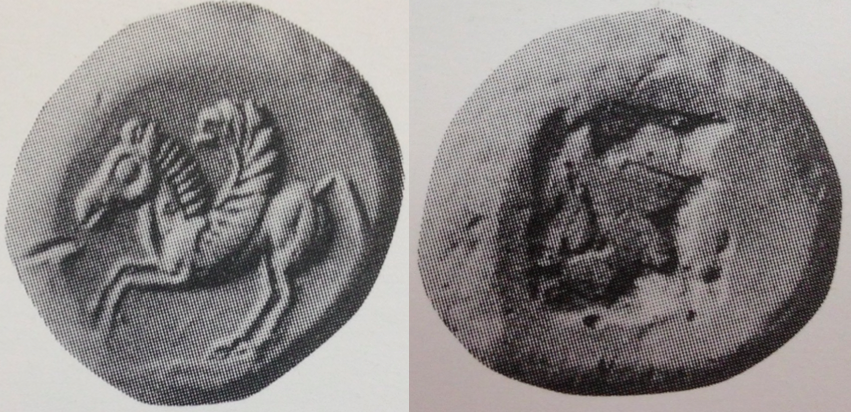Argilos, silver, staters (520-470 BCE): Difference between revisions
From SILVER
No edit summary |
No edit summary |
||
| Line 9: | Line 9: | ||
|Date to=510 BCE | |Date to=510 BCE | ||
|Period=Archaic | |Period=Archaic | ||
|Metal= | |Metal=Silver | ||
|Denomination=stater | |Denomination=stater | ||
|Median weight=14.00 | |Median weight=14.00 | ||
Revision as of 06:31, 3 February 2023
520 BCE - 510 BCE Silver 17,758 kg
Description
| ObverseInscription or printing placed on the obverse.: | Pegasus left or right, galopping, (with bridle). (Border of dots). |
| ReverseInscription or printing placed on the reverse.: | Incuse square divided in four triangles. |
Mint and issuing power
| MintIdentifies the place of manufacture or issue of a numismatic object.: | Argilos | Ancient regionAncient region.: | Macedon | Modern countryModern country: Greece | AuthorityIdentifies the issuing power. The authority can be "pretended" when the name or the portrait of X is on the coin but he/she was not the issuing power. It can also be "uncertain" when there is no mention of X on the coin but he/she was the issuing power according to the historical sources: |
Chronology
| FromIdentifies the initial date in a range assigned in a numismatic context. | 520 BCE | toIdentifies the final date in a range assigned in a numismatic context.. | 510 BCE | PeriodTime period of the numismatic object.: Archaic until 480 BC |
Physical description
| MetalThe physical material (usually metal) from which an object is made.: | Silver |
Median weightMedian of the weights of numismatic objects (in grams). in grams | 14.00 | DenominationTerm indicating the value of a numismatic object. Examples: tetradrachm, chalkous, denarius.: | stater |
StandardStandard.: |
References
| Die study referencePublication of the study: | Liampi 20051Liampi 2005, p. 105-108, no. 1-2, 5 and 7. | ||
| Coin series referenceReference to coin series study: | |||
Obverse dies distribution
| FrequencyFrequency of specimen in distribution. ᵖ | Number of obversesNumber of obverse dies. ᵖ (o) | % (o) | Number of coinsNumber of coins. (n) | % (n) | Die nameName(s) of the die(s). |
| 1 | 17 | 62.96 | 17 | 41.46 | 1, 2, 5, 7, 12, 22, 27, 28, 29, 32, 33, 34, 35, 36, 37, 50, 93 |
| 2 | 7 | 25.93 | 14 | 34.15 | 8, 15, 25, 30, 52, 53, 54 |
| 3 | 2 | 7.41 | 6 | 14.63 | 31, 51 |
| 4 | 1 | 3.7 | 4 | 9.76 | 21 |
| Total | 27 of 27 | 100 | 41 of 41 | 100 |
Reverse dies distribution
no distribution is available
Quantification
| Number of obversesNumber of obverse dies. ᵖ (o) | 4 | Number of singletons (o1)The number of singleton coins. ᵖ | 4 |
| Number of reverse diesNumber of reverse dies. (r) | 4 | Number of coinsNumber of coins. (n) | 4 |
| Coins per obverse dieNumber of coins per obverse die. (n/o) | 1 | Coins per reverse dieNumber of coins per reverse die. (n/r) | 1 |
| Reverse per obverse ratioRatio of obverse dies divided by reverse dies. (r/o) | 1 | Percentage of singletons (o1)number of coins (n) divided by the number of singletons (o1) ᵖ | 100 % |
| Original number of dies (O) (Carter 1983 formula)The estimation of the number of coins according to Carter 1983 ᵖ | 235.29 | Coins struck if 20,000 as average productivity per dieCoins made if the average productivity for obverses (according to Carter) is 20,000. ᵖ | 4,705,800 |
| Original number of dies (O) (Esty 2011 formula)The estimation of the number of coins according to the singleton formula in Esty 2011 ᵖ (O) | Survival rate if 20,000 as average productivity per dieSurvival rate if average productivity is 20,000. ᵖ | 0.00003 | |
| Coverage (o = % of O) (Esty 1984 formula)Esty 1984 - coverage (% of O) ᵖ (o = % of O) | 0% | Die productivity if survival rate 1/2,000Average productivity if survival rate is 1/2,000. ᵖ | 34 |
| Weight of silver (in kg) if 20,000 coins per die (O = Carter formula)Carter 1983 * Median weight * 20000 (*10 if gold or electrum) ᵖ | 65,881 kg <br /> 17,758 kg | Die productivity if survival rate 1/5,000Average productivity if survival rate is 1/5,000. ᵖ | 85 |
Remarks
Metrology p. 230-249.
References
- ^ Liampi, Katerini (2005), Argilos. A Historical and Numismatic Study, Athens
